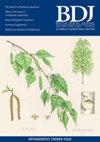漱口水的最新情况:给牙科医生的建议
IF 2.3
4区 医学
Q2 DENTISTRY, ORAL SURGERY & MEDICINE
引用次数: 0
摘要
由于其抗菌成分,漱口水在临床上被认为对减少含细菌的菌斑生物膜和减少牙龈炎症有效。然而,现在有各种各样的产品(通常含有不止一种有效成分),重要的是要考虑哪种化学成分最适合不同类型的口腔疾病,以及如何最好地使用漱口水。因此,本文使用当前的专业指南和最高水平的证据,更新了专业人员的使用技术和选择哪种药物。例如,临床医生需要了解漱口水使用的辅助方法和“吐痰不要用水冲洗”的指示。然而,目前关于漱口水和口腔微生物组(包括全身健康)的证据不足,无法支持微生物组测试来指导选择。在查阅文献后,这篇文章重申,辅助含氟漱口水,以及有效的刷牙和牙缝清洁,对预防龋齿是有效的。辅助氯己定、精油和/或十六烷基吡啶氯化漱口水也可有效地控制早期斑块引起的牙周病。使用漱口水的一些可能的风险被强调,包括过敏、牙齿染色和口腔微生物群失调。在获得更多证据之前,临床医生应确保益处大于风险,并参考现行的漱口水指南来支持个性化的预防保健建议。本文章由计算机程序翻译,如有差异,请以英文原文为准。
An update on mouthwashes: advice for dental practitioners
Due to their antimicrobial constituents, mouthwashes are well-known to be clinically effective for reducing plaque biofilms containing bacteria and reducing gingival inflammation. However, with a variety of products now available (often containing more than one active ingredient), it is important to consider which chemical constituents are most suitable for different types of oral disease and how mouthwashes should be best used. This article thus updates professionals on techniques for use and which agent to select, using current professional guidelines and the highest level of evidence available. As examples, clinicians need to be aware of adjunctive approaches for mouthwash use and ‘spit don't rinse with water' instructions. However, there is currently insufficient evidence on mouthwashes and the oral microbiome (including systemic health) to support microbiome testing to guide a choice. After consulting the literature, this article reiterates that adjunctive fluoride mouthwashes, alongside effective toothbrushing and interdental cleaning, are effective for preventing dental caries. Adjunctive chlorhexidine, essential oils and/or cetylpyridinium chloride mouthwashes may also be effective for managing plaque-induced periodontal diseases at early stages. Some possible risks to mouthwash use are highlighted, including allergies, tooth staining and oral microbiome dysbiosis. Until more evidence is available, clinicians should ensure that benefits outweigh risks and refer to current mouthwash guidelines to support personalised preventive care advice.
求助全文
通过发布文献求助,成功后即可免费获取论文全文。
去求助
来源期刊

British Dental Journal
医学-牙科与口腔外科
CiteScore
3.10
自引率
15.40%
发文量
1096
审稿时长
4-8 weeks
期刊介绍:
The role of the BDJ is to inform its readers of ideas, opinions, developments and key issues in dentistry - clinical, practical and scientific - stimulating interest, debate and discussion amongst dentists of all disciplines. All papers published in the BDJ are subject to rigorous peer review.
 求助内容:
求助内容: 应助结果提醒方式:
应助结果提醒方式:


